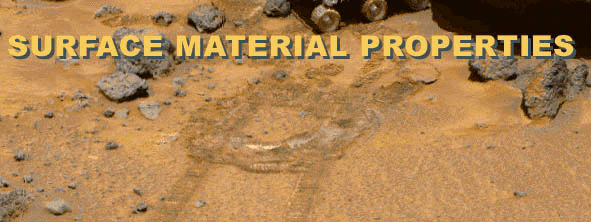

Soils at the landing site vary from the bright-red dust to darker-red and darker-gray material. Overall, the soils are lower in silicon than the rocks and richer in sulfur, iron and magnesium. Soil compositions are generally the same as those measured at the Viking sites, which are on opposite hemispheres (Viking 1 is 800 kilometers west of Pathfinder; Viking 2 is thousands of kilometers away on the opposite, eastern side of the Northern Hemisphere). Thus this soil may be a globally deposited unit. The similarity in compositions among the soils implies that their differences in color may be due to slight variations in iron mineralogy or in particle size and shape. A bright-red or pink material also covered part of the landing site. Similar to the soils in composition, it seems to be indurated or cemented because it was not damaged by extensive scraping using the rover wheels.
Howard Eisen, JPL
Principal Investigator, Soil Mechanics Technology Experiment
Poptart.gif Source: Rover Front Right Camera
Pop-tart, a small rock or indurated soil material was pushed out of the surrounding drift material by Sojourner's front left wheel during a soil mechanics experimentRF26110.gif Source: Rover Front Right Camera
The Rover is located next to Pooh bear(rock at left) and Piglet (not seen)as it looks out toward Mermaid Dune. The soil textures differ from the foreground where the soil a poorly sorted mix of small rocks, fines and clods to the area a bit ahead of the rover where the surface is covered with a bright drift material.Soil experiments where the rover wheels dug in the soil revealed that the cloddy material exists underneath the drift.front_yogi.gif Source: IMP
The Rover, while on its way to Yogi, performed several soil mechanics experiments. Piles of loose material churned up from the experiment are seen in front of and behind the Rover. Pop-tart is visible near the front right rover wheel.Shaggy_sol23.gif Source:IMP
The IMP caught this image of the Rover as it was digging in the "compressible" material near Casper to determine the soil's mechanical properties.Shaggy is the large rock behind the Rover.
layer1_th.gif This chart illustrates evidence of layering found with the Sojourner rover soil mechanics experiment. In this investigation, the rover wheels are spun while simultaneous measurements of motor currents, vehicle kinematic configuration, and temperature are recorded. From these data, wheel torque and, in turn, shear force at the soil/wheel interface are computed. This tractive coefficient (analogous to friction coefficient) is used to characterize the soils. layer2_th.gif The chart above shows graphical representations of some soil structures determined by the Sojourner rover soil mechanics experiment.